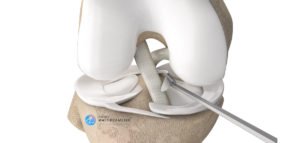During its congress in Rennes in December 2019, the Société Francophone d’Arthroscopie [Francophone Arthroscopy Society] published a press release alerting to the fact that the removal of the meniscus was still too commonplace in the case of meniscal damage.
Indeed, the two menisci in the knee act as “cushions” between the femur and the tibia and play an essential role in protecting the cartilage by absorbing shocks and spreading the load in the joint.
In the case of meniscal damage, removal of the meniscus (meniscectomy) is far from routine. Even if the consequences are negligible in patients over 40-45 years, it can result in early wear of the cartilage (osteoarthritis) in younger patients for whom everything possible must be done to spare the torn meniscus and help it heal.
Different types of meniscal tear and their treatment
The treatment of meniscal damage will depend on three things:
- The age of the patient
- If the tear is traumatic or degenerative
- The shape of the tear, assessed by MRI, which determines whether it can be repaired or not
In young patients (< 35 years)
Traumatic lesions are the most common. Non-traumatic lesions are rare and can be linked to “abnormal” frailty of the meniscus due to a lack of vascularisation or early degenerative ageing.
In young patients, it is necessary to do everything possible to spare the meniscus by helping it heal with surgical suturing performed arthroscopically. Healing is possible when the damage is located in a properly vascularised area of the meniscus, which is not at all the case with some unstable, mobile lesions.
Statistically, the best results are obtained with traumatic lesions rather than degenerative lesions and when the lateral meniscus rather than the medial meniscus is involved.
In older patients (> 40 years)
Non-traumatic lesions are by far the most common meniscal lesions and are linked to the natural ageing of the meniscus, which gradually loses its resistance and cracks during trivial movements. In most cases, the moment when the damage occurs can go unnoticed and remain asymptomatic for many years.
Degenerative damage does not heal very well, which is why no meniscal suture is proposed after the age of 40 and the choice of treatment will depend on the stability of the meniscal lesions.
Stable degenerative lesions with a meniscal crack and no detachment of a mobile meniscal fragment often remain asymptomatic for a long time and the pain can appear later during or after sports activities. The treatment of these stable lesions in “older” subjects is medical and involves taking anti-inflammatories, corticosteroid injections, temporarily stopping sport, and possibly wearing orthopaedic insoles. It is only when this medical treatment is ineffective that a partial meniscectomy can be considered.
Unstable degenerative lesions have a specific shape with a mobile fragment of meniscus that breaks loose causing, in addition to pain, a feeling of locking or knee instability. These lesions respond poorly to medical treatment as the latter does not stabilise the mobile fragment resulting in persistent discomfort. It is, therefore, common to propose an arthroscopic partial meniscectomy from the outset to remove only the mobile part of the meniscus.
| Stable lesion | Meniscal suture if possible, otherwise partial meniscectomy | |
|---|---|---|
| AGE < 35 - 40 YEARS traumatic >> degenerative | Meniscal suture | Meniscal suture if possible otherwise partial meniscectomy |
| AGE > 35 - 40 YEARS degenerative >> traumatic | Medical treatment if fails: meniscectomy | Partial meniscectomy |
In summary…
The treatment of meniscal lesions depends primarily on age.
In young subjects for whom these lesions are uncommon, it is necessary to do everything possible to spare the meniscus by proposing arthroscopic suture of the lesion whenever possible to limit the risk of developing early osteoarthritis.
In subjects over 40 years, these lesions are common and are just part of the normal ageing of the menisci. Treatment is mainly medical, except in the case of an unstable meniscal fragment where it is necessary to carry out an arthroscopic partial meniscectomy which, at this age, results in little or no development of osteoarthritis.
Discover the operation linked to this article:

Arthroscopic Meniscal Surgery
Meniscus cracks are common. Most are degenerative due to the natural wear of the meniscus and others are caused by trauma. In some cases, surgery may be necessary. This is the case when a small piece comes away causing the knee to lock, in the event of meniscal damage in young subjects that can be repaired, or damage that is not relieved by medical treatments (injections). According to the age of the patient, as well as the type, shape, and location of the meniscal damage, the meniscus will be sutured or the damaged area removed. This operation is performed using arthroscopic surgery, a minimally invasive surgical technique.

